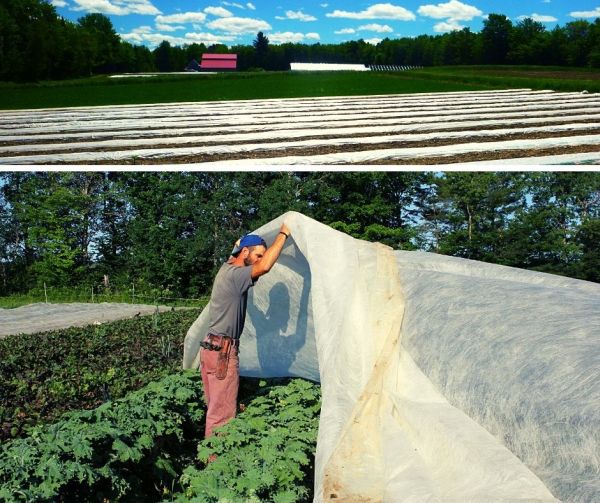How To Keep Cucumber Beetles And Other Garden Pests Away Without Chemicals
Some of the most common questions we get are:
How do you deal with pests on your organic farm?
How to deal with the cucumber beetles that come every year and destroy my plants before they can make fruits at all or very many?
Why do my radish leaves always have so many holes in them that they don't do much on the root part?
I don't like getting worms in my cauliflower/broccoli/cabbage. What do I do?
Well, the easy answer is: spray them with the latest and greatest chemical big ag is offering, right?
Wrong!
Not for you, am-I-right?
You'd like to do it as organically as possible. You're concerned about chemical use on farms and consequently on the food that you choose to eat and feed your children and grandchildren.
And, why not? Chemicals are known to kill bees, cause cancer, and a whole host of other things.
I understand your concern about the dangers of chemicals.
I realized what chemicals were doing to people and the planet when I was in my early twenties.
Consequently I jettisoned my college degree in Political Science to devote my entire adult life to avoiding chemicals for first myself, then for my farm's customers, and now for my children.
But luckily there is a third way between using chemicals and letting bugs devour your precious garden that you worked so hard to plant and take care of.
And that is what I'm here to help with!
How to keep cucumber beetles and other garden pests away without using chemicals
The solution is row cover. Have you seen it before?

It’s a white fabric that lets in air, light, sunlight, and rainwater, but excludes pests big and small. You completely cover the plants and they grow under it. It floats over them and is not too heavy to weigh them down.
And the best part: it works!
What crops can row cover help exclude pests from?
Row cover is extremely versatile. Here's a list of things that you can use it to exclude pests of different kinds:
- Potatoes (potato beetles, burying the edges is recommended)
- Kale (flea beetles, cabbage worms)
- Cabbage (flea beetles, cabbage worms)
- Cauliflower (flea beetles, cabbage worms)
- Broccoli (flea beetles, cabbage worms)
- Collard Greens (flea beetles, cabbage worms)
- Bok Choy/other Asian greens (flea beetles, cabbage worms)
- Summer squash (cucumber beetles, squash bugs)
- Winter squash (cucumber beetles, squash bugs)
- Cucumbers (cucumber beetles, squash bugs)
- Watermelons (cucumber beetles, squash bugs)
- Eggplant (potato beetles)
How to apply row cover to your crops:
It's easy! Don't be intimidated! Here's an easy step-by-step to help you get going:
- Plant your seeds or transplant your seedlings as you normally would. Water appropriately.
- Drape the fabric over the plants or seeds. You want it to lay loosely and allow for air to move it around and for room for the plants to grow. Gene always says to allow for "knee high slack".
- Figure out a method for holding the fabric in place. You can cover the edges with soil, use sandbags, use firewood or other scrap wood, rocks from the garden, cinder blocks, etc. Yes, it is okay if it touches the plants. They can handle it.
We use a garden hoe to make a furrow, lay the edge of the fabric in the furrow, and use the same garden hoe to cover back over the soil. - Leave it there until one of the following situations arises:
Next steps for a crop that doesn't need pollination (like greens, heading brassicas, potatoes)
- You may need to weed or check crop status, so open it up and do what you need to do, and recover immediately.
- Then leave the row cover on until you harvest it.
- If it is a cut and come again crop like kale or other greens, remove it to harvest and then replace it until you are done harvesting the crop.
Next steps for a crop that needs pollination to set fruit (like tomatoes, cukes, eggplant, peppers, squash, etc.)
- You may need to weed or check crop status, so open it up and do what you need to do, and recover immediately.
- Then when the plant begins to flower, remove the row cover and keep it off. The pests will then descend, but the plants will be big enough to handle their damage without being destroyed. It works, I promise, as this is what we do!
General tips for using row cover:
- It can be used again and again with proper care and maintenance. When lifting it up, use care not to tear it or that can weaken it and/or allow bugs to get in.
- It's hard to see through row cover to properly monitor crop health and weed growth. So plan to take it up at least once while your crop is growing to monitor and/or weed.
- It does add a little extra heat to the crops growing underneath it, which is in some cases good. We use it just for that purpose over our tomato plants after we first transplant them to give them extra warmth for a few weeks before flowering. But, caution: if you transplant when it is REALLY hot and then cover with row cover, make sure to check on your plants and water another extra time or two to make up for the extra heat. Once they get established, it won't matter.
How to clean up and store row cover?
Yes! You can reuse the row cover year after year as long as you take care of it and don't tear holes in it.
Here are my tips for clean up and storage of row cover:
- Find a time when your row cover is DRY! It holds moisture so it takes a long time to dry if it is wet when you pick it up.
- Roll it up into a ball.
- Store it inside a shed or your garage or somewhere undercover to keep it from getting wet and undue rodent pressure.
It's okay if it's dirty! The dirt will mostly shake off when you unroll it for use the next year.
Where to source row cover and how to know what to get?
Row cover is made of spunbonded fabric (like the same stuff that they use to make masks!) and comes in many brands, different weights (think thicknesses or guage), and different widths and lengths.
Because everyone's garden is unique, it is best for you to assess your needs individually based on how many plants or bed feet you want to cover. See the list above for ideas on which plants would benefit from cover.
- Brands: It doesn't matter which brand you buy. We've tried several brands and all of the spunbonded fabric is similar.
- Weights/thicknesses/guage: 0.55 oz/square yard is the typical all purpose weight that we use for most things and has approx. 85% light transmission. There is a heavier weight of 1 oz+/square yard with approx. 70% light transmission that will also work and doubles for frost protection. The trade off is the heavier the fabric the more light it blocks. So the medium weight is what we think is the most all purpose.
- Widths and lengths: Row cover is typically sold in widths of 7-10 feet and lengths starting at 50 feet. Which is a lot for a small garden! You can cover a whole row in your garden of several kinds of plants or one kind of plant, whichever works for you. Or you can cut it and cover a raised bed. Just remember once you cut it, you can't get it back to the longer length so plan wisely!
- Sources (and, no, I don't get a commission or any kickbacks for this!): Johnny's Selected Seeds in Winslow and Fedco Organic Grower's Supply in Clinton are two local businesses that have it and you can pick it up on site to save on shipping costs.
Okay, yeah yeah, that was a lot of info, but how do I get started?
You're right! There's a lot of info there, but if you want to just jump in:
- Buy a few seedlings and get a small piece of row cover. (If you buy seedlings from us and come early to get them, you can take some short leftover pieces from us for free!)
- Put the row cover over the ones that need it (see above). Cucumbers are a good place to start.
- Weigh it down with garden soil or whatever you've got.
- Wait for it to grow and then pull it off when the cucumbers flower!



Add new comment
Comments (1)
Garden pest control
Fri, 2022-04-01 10:33